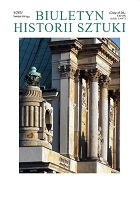Warszawskie dzieło architektury à la française. Dzieje budowy i geneza fasady kościoła karmelitów bosych
A Piece of Architecture à la Française in Warsaw. History of the Construction and Origins of the Façade of the Church of the Discalced Carmelites
Author(s): Paweł Migasiewicz, Jakub SitoSubject(s): Christian Theology and Religion, Architecture, History of Church(es), 18th Century, History of Art
Published by: Instytut Sztuki Polskiej Akademii Nauk
Keywords: Baroque; Neo-Classicism; Discalced Carmelites; Ephraim Schröger; Warsaw architecture; French architecture; Church of the Discalced Carmelites in Warsaw;
Summary/Abstract: The sumptuous exquisite stone façade of the Church of the Discalced Carmelites in Warsaw was raised in 1761/1762-1779 after the design of Ephraim Schröger (1727-1783). Its architecture with columns and pilasters: rational, moderate, albeit rich in detail, is close to the traditional column façades created in France for churches and secular structures from the first half of the 16th century until the second half of the 18th century. The majority of authors discussing it, as if leaving aside its rooting in this tradition, regarded it to be a leading example of the Warsaw variant of NeoClassicism gaining its shape in the 1760s as a new stylistic proposal. On the other hand, it was admitted that when designing the Carmelite Church façade, Schröger had applied the model from one or several contemporary French prints (mainly by Blondel). Neither of the stands is correct. Neo-Classicism present in the Warsaw façade was a new style only within the Polish architecture, not the French one where it had been present from Serlio and Lescot’s times. On the other hand, it would be an excessive simplification to reduce the impact of the French tradition in Schröger to the inspiration drawn only from prints. The paper’s Authors demonstrate that the discussed illustrious Warsaw architect was perfectly familiar with that tradition, possibly much better than any other Polish architect of his generation, and almost as well as French architects were. It may be supposed that he visited France already in the 1750s, where he was educated many years before his famous trip to Western Europe financed by King Stanislaus Augustus in 1766.
Journal: Biuletyn Historii Sztuki
- Issue Year: 83/2021
- Issue No: 4
- Page Range: 883-921
- Page Count: 39
- Language: Polish

